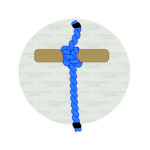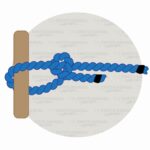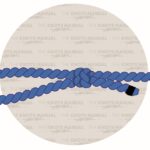A clove hitch is a binding knot that is insecure — it can slip and bind at the same time. The clove hitch—rope end is the same kind of knot, but the knot sits at the end of the rope.
Follow the simple steps below to learn how to tie a clove hitch—rope end knot.
What Is A Clove Hitch Knot?
Clove hitch knots are knots that can work as crossing or binding knots. They comprise two half hitches around an object.
Clove hitches have been around since at least the 16th century. They have applications in rock climbing, theater, boating, and camping. Experts warn that they are unsafe, and users should never work with them alone.
The clove hitch originally appeared in The Ashley Book of Knots to warn against its use. It slips easily but also binds. Never use clove hitches by themselves because they are very untrustworthy.
What Is A Clove Hitch—Rope End Knot?

A clove hitch—rope end knot is a temporary knot. Basically, it is a clove hitch that has been made by threading the end of the rope.
How To Tie A Clove Hitch—Rope End Knot

Follow the six simple directions below to learn how to tie this knot:
Step 1:

Pass the working end around the pole.
Step 2:

Pass the working end over the rope’s standing end.
Step 3:

Pass the working end around the pole a second time.
Step 4:

Thread the working end under itself as shown in the figure.
Step 5:

Pull upward on the working end to tighten the knot.
Step 6:

The knot is formed from two half hitches — this is noticeable when the knot is loosened.
Uses Of The Clove Hitch—Rope End Knot
These knots are often used on theater stages for holding scenery and other stage props. Clove hitches allow crew members to adjust the height of stage curtains. All they have to do is slightly roll the knot. Yet, many stage managers don’t let their crew use clove hitches because they slip and bind easily.
Additionally, these knots are effective for mooring a buoy.
Boaters can also use them to secure boat fenders to a railing temporarily.
Alternate Tying Methods
There are two other ways of tying the clove hitch:
Using Half Hitches: this version is suitable for attaching a rope to a ring or pole. They are simple to tie but are weak.
Using Stacked Loops: this version is suitable for attaching a rope to a ring or pole. Like the above method, it is simple to tie but is weak.
FAQs
Is The Clove Hitch—Rope End Different Than The Clove Hitch?
No, they are the same knot. The difference is where and how the knot is tied. The clove hitch has several tying variations. As the name suggests, the clove hitch—rope end knot is tied at the end of the rope.
What Is Better Than The Clove Hitch?
The clove hitch is an unsafe knot; use should generally be avoided.
Instead, consider using the constrictor knot. It is one of the most effective and secure binding knots. Once it is tied, it is nearly impossible to untie it again, making it very safe. Constrictor knots are made similarly to clove hitches, but one end passes under the other. It forms an overhand knot under a riding turn.




